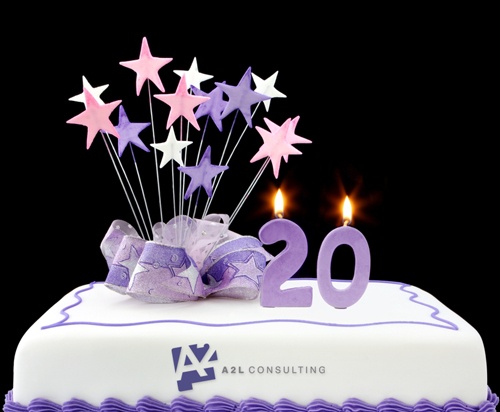 by Ken Lopez
by Ken Lopez
Founder/CEO
A2L Consulting
Today is the 20th anniversary of the founding of A2L. We literally started in a closet not long after I finished law school. First, we were Animators at Law. Then almost five years ago, we became A2L Consulting to reflect the fact that litigation graphics were now less than half of our business. Jury consulting, trial technology support and litigation advisory services are now a bigger part of what we do.
Twenty years later, we're a national litigation consulting firm and arguably, the very top litigation consulting firm in the country. That's not mere puffery. We're consistently voted #1 in local and national legal industry surveys.
To celebrate our 20th, here are 20 new realities that litigators, in-house counsel and litigation support professionals should consider.
1. The New CLE: It is a rare CLE seminar that does not put us all to sleep. I think that modern formats of continued learning like our Litigation Consulting Report blog and other litigation blogs, including those recognized by the American Bar Association, are the best places to go for continued learning. It’s time for the legal establishment to agree.
2. The power of storytelling: The science behind the effectiveness of storytelling as a persuasion device is just now coming into view. It is critical for litigators to study this field and to understand the insights it has developed. See, Storytelling for Litigators E-Book 3rd Ed.
3. Big firm litigators rarely try cases: As a result of this new reality, litigators must get a new kind of help - help from trial tested litigation consultants. These courtroom experts may participate in 50-100 trials per year. It just stands to reason that they can help a litigator who is in court far less frequently. See, With So Few Trials, Where Do You Find Trial Experience Now?
4. Using PowerPoint incorrectly does more harm than good. Most lawyers will actually design slides for themselves that will reduce overall persuasion - but they don't have to. See, How Much Text on a PowerPoint Slide is Too Much?
5. Juror expectations are on the rise: Jurors expect litigators to wow them a bit with graphics and to keep them interested. They know what can be done in the form of graphics and at a lower price than ever before. See, Will Being Folksy and Low-Tech Help You Win a Case?
6. The ability to test is on the rise: The often high price of mock trials scares off many, but almost every case deserves some form of testing. To make this possible, our firm and others have developed a wide range of testing methodologies that can fit every budget. See, Introducing a New Litigation Consulting Service: the Micro-Mock™
7. Persuasive visuals are everywhere. From White House press releases, to the courtroom, to advocacy organizations, the world is waking up to the power of persuasive graphics. See, Persuasive Graphics: How Pictures Are Increasingly Influencing You
8. All filings use visuals now. It used to be incredibly rare to see persuasive litigation graphics used in court filings, but now it is commonplace. See, 14 Places Your Colleagues Are Using Persuasive Graphics (That Maybe You're Not)
9. Law firms will become even more like businesses: Law firm marketing, business development and PR were unheard of 20 years ago. Law firm pricing strategies are a new and emerging field. Yet all of these areas are normal functions of even small businesses. Increasingly, law firms will look more like businesses going forward, embracing more transparency and developing sales teams. See, 24 Things to Know About The "New Normal" of The Legal Economy
10. Courtrooms are more electronic, but there are not all there yet. We still bring equipment into most trials. There are many things you need to check with the court. And a great deal still depends on the predilections of the judge. See, Trial Technicians, Hot-Seat Operators and Trial Technology
11. The science of persuasion is real science. Neurological research has shown that particular regions of the brain are activated when a person is persuaded by an argument. New findings are constantly emerging. See, 8 Videos and 7 Articles About the Science of Courtroom Persuasion
12. For a small trial, you can use an iPad and TrialDirector (for free). It's not something you want to try in a document intensive case, but for a case with a handful of documents and just a few video depositions, this is now a reasonable strategy to consider. See, 5 Tips for Using TrialDirector and Trial Technicians Effectively
13. Mock hearings are routine. From mock Markman hearings, to mock Federal Circuit appeals, trial consultants can and do provide mock sessions that hone litigators’ skills and show them what to expect. See, 11 Surprising Areas Where We Are Using Mock Exercises and Testing
14. Graphics in depositions. We are increasingly being called upon to create demonstrative evidence to be used during depositions. See these deposition articles generally.
15. Animation is used selectively. Once, animation was the be-all-end-all of the demonstrative evidence industry. 3D animation at least is now only used in big ticket cases involving complicated mechanisms that must be seen from multiple angles or anytime we want a jury to experience "seeing is believing." See, What Does Litigation Animation Cost? (Includes Animation Examples)
16. Animation is more PowerPoint than Pixar. These days, we create a lot of animation, but almost all of it is done in PowerPoint. Now, don't be fooled, you can do some pretty sophisticated work in PowerPoint now. Have a look: 16 PowerPoint Litigation Graphics You Won't Believe Are PowerPoint
17. Voir dire testing is real science not gut instinct. There was a time when jury consultants were a lot of flash, bravado and gut instinct. Those days are now gone. Now, the great jury consultants let data based on testing speak about how best to conduct jury selection. See, 12 Insider Tips for Choosing a Jury Consultant
18. Judge expectations. Just as juror expectations have risen so have the expectations of most judges. They are not looking for CSI. Rather, they are looking for a much more efficient presentation of the evidence through the use of well thought through litigation graphics and even the design of ipad-compatible hyperlinked briefs. See, Hyperlinking Briefs: Be More Persuasive Using The iPad
19. The use of litigation consultants as coaches is on the rise. I know I'm biased, but if I were in-house, I would insist that my outside litigators worked with a firm like ours. With so much at stake and so few trials occuring, getting a third-party view of a case has enormous ROI in a big-ticket case. See, 25 Things In-House Counsel Should Insist Outside Litigation Counsel Do
20. Great litigation consulting firms endure, adapt and grow. Our firm was founded as an animation for lawyers firm, then it became a graphics for lawyers firm, then a litigation consulting firm (as far as I know we coined the use of that term in 1998), then a trial technology and litigation graphics firm, then a jury consulting and litigation graphics firm, and now our work advising in-house counsel about how to get great results from outside litigation counsel is taking A2L into new areas still. We'll keep adapting and growing, and I hope you'll join us in that effort.







Leave a Comment